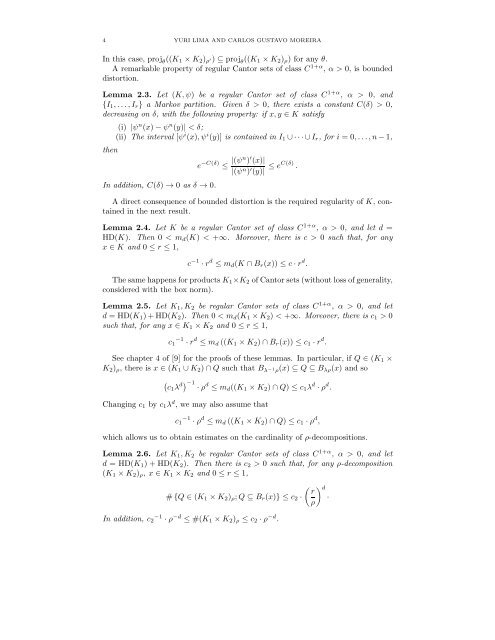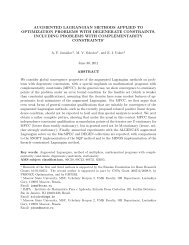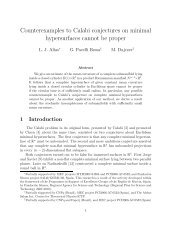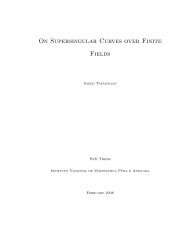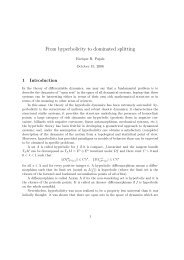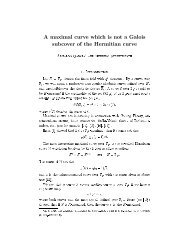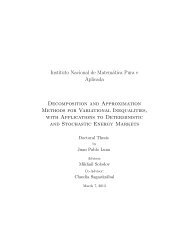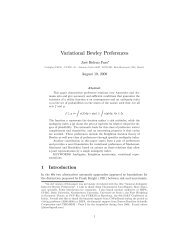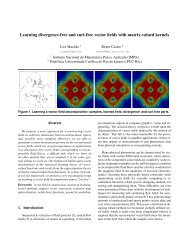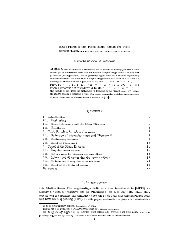A COMBINATORIAL PROOF OF MARSTRAND'S THEOREM FOR ...
A COMBINATORIAL PROOF OF MARSTRAND'S THEOREM FOR ...
A COMBINATORIAL PROOF OF MARSTRAND'S THEOREM FOR ...
Create successful ePaper yourself
Turn your PDF publications into a flip-book with our unique Google optimized e-Paper software.
4 YURI LIMA AND CARLOS GUSTAVO MOREIRA<br />
In this case, proj θ ((K 1 ×K 2 ) ρ ′) ⊆ proj θ ((K 1 ×K 2 ) ρ ) for any θ.<br />
A remarkable property of regular Cantor sets of class C 1+α , α > 0, is bounded<br />
distortion.<br />
Lemma 2.3. Let (K,ψ) be a regular Cantor set of class C 1+α , α > 0, and<br />
{I 1 ,...,I r } a Markov partition. Given δ > 0, there exists a constant C(δ) > 0,<br />
decreasing on δ, with the following property: if x,y ∈ K satisfy<br />
then<br />
(i) |ψ n (x)−ψ n (y)| < δ;<br />
(ii) The interval [ψ i (x),ψ i (y)] is contained in I 1 ∪···∪I r , for i = 0,...,n−1,<br />
In addition, C(δ) → 0 as δ → 0.<br />
e −C(δ) ≤ |(ψn ) ′ (x)|<br />
|(ψ n ) ′ (y)| ≤ eC(δ) .<br />
A direct consequence of bounded distortion is the required regularity of K, contained<br />
in the next result.<br />
Lemma 2.4. Let K be a regular Cantor set of class C 1+α , α > 0, and let d =<br />
HD(K). Then 0 < m d (K) < +∞. Moreover, there is c > 0 such that, for any<br />
x ∈ K and 0 ≤ r ≤ 1,<br />
c −1 ·r d ≤ m d (K ∩B r (x)) ≤ c·r d .<br />
ThesamehappensforproductsK 1 ×K 2 ofCantorsets(withoutlossofgenerality,<br />
considered with the box norm).<br />
Lemma 2.5. Let K 1 ,K 2 be regular Cantor sets of class C 1+α , α > 0, and let<br />
d = HD(K 1 )+HD(K 2 ). Then 0 < m d (K 1 ×K 2 ) < +∞. Moreover, there is c 1 > 0<br />
such that, for any x ∈ K 1 ×K 2 and 0 ≤ r ≤ 1,<br />
c 1<br />
−1 ·r d ≤ m d ((K 1 ×K 2 )∩B r (x)) ≤ c 1 ·r d .<br />
See chapter 4 of [9] for the proofs of these lemmas. In particular, if Q ∈ (K 1 ×<br />
K 2 ) ρ , there is x ∈ (K 1 ∪K 2 )∩Q such that B λ −1 ρ(x) ⊆ Q ⊆ B λρ (x) and so<br />
(<br />
c1 λ d) −1<br />
·ρ d ≤ m d ((K 1 ×K 2 )∩Q) ≤ c 1 λ d ·ρ d .<br />
Changing c 1 by c 1 λ d , we may also assume that<br />
c 1<br />
−1 ·ρ d ≤ m d ((K 1 ×K 2 )∩Q) ≤ c 1 ·ρ d ,<br />
which allows us to obtain estimates on the cardinality of ρ-decompositions.<br />
Lemma 2.6. Let K 1 ,K 2 be regular Cantor sets of class C 1+α , α > 0, and let<br />
d = HD(K 1 ) +HD(K 2 ). Then there is c 2 > 0 such that, for any ρ-decomposition<br />
(K 1 ×K 2 ) ρ , x ∈ K 1 ×K 2 and 0 ≤ r ≤ 1,<br />
( ) r<br />
#{Q ∈ (K 1 ×K 2 ) ρ ;Q ⊆ B r (x)} ≤ c 2 ·<br />
d·<br />
ρ<br />
In addition, c 2<br />
−1 ·ρ −d ≤ #(K 1 ×K 2 ) ρ ≤ c 2 ·ρ −d .


